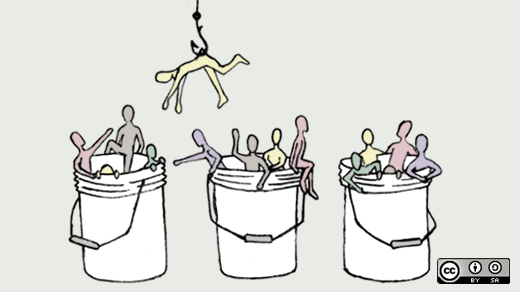Over the years, I’ve picked up an unhealthy understanding of the language of business. Years of sitting in big corporate meetings will do that to you, unfortunately.
Here at New Kind, my business partners will still call me out for talking about “action items,” saying something is in our “wheelhouse,” or jumping straight to the “net-net.”
But perhaps the business term I love to hate the most is the word bucketize, which I’d translate as “to organize into broad categories.” Common usage might include statements like the following:
“I’m going to bucketize these requirements.”
or
“We’ve bucketized the skillsets we need for this project.”
It’s not just the word that I dislike either, but the entire concept of bucketizing things, which often means taking complex relationships and oversimplifying them in order to fit into broad buckets designed to hold everything except much meaning. Bucketizing often puts things into silos (another favorite business word), destroying valuable connections between ideas, tasks, or people ending up in, well, different buckets.
Perhaps the most egregious example of corporate bucketizing for me is the typical corporate org chart, which looks something like this.

In most organizations, each person sitting at the executive table has their own employee bucket. As an executive, you are often motivated to fill your bucket with as many people as possible, because the more people you have working for you, the more power you control in the organization.
The problem? The org chart is an oversimplified, semi-fictional construct.
It rarely represents an accurate view of the complex web of working relationships found within an organization where people in different buckets communicate and work with each other all of the time. Yet, even though it is mostly fiction, the org chart often creates real power for executives to wield.
Which explains why executives spend lots of time contemplating extensive restructurings that are often no more than glorified org chart reconfigurations and in many cases cause more harm (in terms of wasted energy and time) than good.
Don’t get me wrong, I believe organizational reconfiguring is useful, healthy, and should be an ongoing process in the open source spirit of release early, release often. My experience leads me to suspect that making small organizational modifications regularly as problems and opportunities emerge may be less disruptive and more effective in the long run.
So what might an de-bucketized org chart look like? I look no further than our galaxy itself for inspiration.

At the center of the Milky Way, there is some great gravitational force (thought to be a supermassive black hole) that all the stars orbit. The stars tend to organize themselves into clusters and bands, and many of the stars have planets, asteroids, and other space stuff orbiting around them individually.
A couple of key characteristics that define a galaxy like ours. First, the galaxy is in motion, it is constantly changing. Second, everything is in orbit around a common core. Some stars may be in tight orbits near the center, others may be further away.
If we de-bucketized an org chart using the Milky Way as a model, it might become something like this:
- Rather than having a person at the top of the org chart, we’d have a mission—the mission for the organization—as the center of gravity around which everything else orbits.
- The leader of the organization (Chairman, CEO, or whatever) would be the prime caretaker of the mission, and their work would be to ensure resources are aligned to most effectively achieve that core mission.
- People would work for the mission first—not for a person.
- Clusters of individuals could gather around tasks that help achieve the mission. Some of these might be tasks aligned like traditional organizational departments such as finance or sales, others might be temporary clusters formed around strategic priorities.
- People would emerge as the leaders and caretakers of each task as they are recognized by senior leaders for their contributions to the core mission, but also by those around them who recognize and trust their good work and effective leadership.
And of course in every organization, there are “comets” moving in extremely strange orbits, often contributing to multiple tasks or groups along the way. You’ve probably met a few of the comets in your organization, and some people playing this role are more valuable than others.
But a traditional org chart doesn’t account for the value that comets can bring in cross-pollinating ideas between different clusters (side note: some people are now crediting comets with bringing the building blocks for life to Earth!). These people are often placed into one bucket that only partially defines their role and value.
In this imaginary organizational galaxy, individuals may have many forces pulling them in interesting directions, and over time they may be able to become leaders of tasks having gravitational forces of their own. As long as these folks continue to orbit around the core mission they can maintain some control of their own destiny and avoid simply becoming yet another person shoved into a executive’s bucket.
I’ve hated org chart bucketizing for a long time, and have struggled to build a model that better reflects the central role of the enduring mission of the organization rather than the (often temporary) executives charged with overseeing it.
I’ve actually tried and implemented my own org chart designs that purposefully avoid the tendency to bucketize people, but I’ll admit I’ve not yet come up with anything I truly love.
How about you? Do any of you have ideas for how to better document or illustrate organizational relationships without resorting to bucketizing? Other metaphors that work for you? I’d love to hear them.






2 Comments